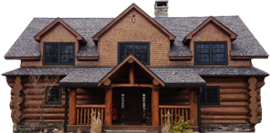Frequently Asked Questions
- With your headquarters in Northern Vermont, how far can you travel to do projects?
- Does media or corn blasting damage or deteriorate the surface of the logs?
- How often should I have my log home cleaned and touched up?
- I have some significant rot in the logs on one side of our home. How can you replace them when they are 20 years old and make it look original.
- How do I protect my log home from insects that damage the logs?
- Are there any environmental issues resulting from media blasting my log home?
Q. With your headquarters in Northern Vermont, how far can you travel to do projects?
A. Given our transport capability, we can service a wide area including – Connecticut, Rhode Island, Massachusetts, New Hampshire, Maine, New York, and northeastern Pennsylvania. We are accustomed to the logistics of working away from our home base and have developed the systems to support us. We have materials dropped shipped to job sites, make living arrangements for crews to work for weeks at a time, and are well-prepared for the contingencies that arise on any project. Last year we did a large project just outside of New York City and was able manage the project for an on-time completion even with the effects of Hurricane Sandy.
Q. Does media or corn blasting damage or deteriorate the surface of the logs?
A. You have to know what your doing when you start blasting someone's home. Properly done, media blasting with corn cob husks or glass beads does not damage the log surface. With years of experience, we are adept at removing the old finish, mold, and discoloration without eating into the logs and leaving a new surface to readily accept stains and sealants. To see how it's done, go to our Media Blasting page on the website and see the video of Jason stripping and older log structure – it's a very cool to see how clean and new the surface looks.
Q. How often should I have my log home cleaned and touched up?
A. At a minimum, you should inspect your home every year to look for areas that have been adversely effected by weather, excessive water run-off or pests. You should pay special attention to the log ends on corners where exposure to rain and snow/ice can start weakening the surface and begin to allow rot or pests to take hold. Make sure your shrubs and tress are away from the side of the house allowing the logs to breath properly and have the necessary airflow to help them stay dry. Remember, Dry Logs are Healthy Logs!!
As far as a maintenance schedule, we recommend a SoftWash at least every two years along with a stain, chink and caulk touch up where needed. Some homes may require an annual cleaning due to their weather exposure, age, and the amount of time since they were refinished. You can go to our Maintenance page for more details on the SoftWash cleaning and see the results of our work. If you need more assistance, just get intouch on our Contact page and we'll give you a call to discuss your situation.
Q. I have some significant rot in the logs on one side of our home. How can you replace them when they are 20 years old and make it look original.
A. This is a very common concern with owners of older log homes. We have been crafting replacement logs for years and have been very successful in making them blend into the existing structure. In some cases, we can purchase logs that will match, but in many cases we have to craft the log(s) by hand. First we identify the species of log, then we carefully cut and shape the log(s) to match the style and profile of the remaining logs. Once we get everything in place, we blend or re-stain the entire section that's being repaired. Take a look at our Log Replacement/Rot Repair page for more detail and pictures of our work. Over the years, we done some very difficult repairs requiring significant structural and framing work and our clients have always been pleased with the results.
Q. How do I protect my log home from insects that damage the logs?
A. First of all, the home needs to be protected and sealed with a high quality stain, have the chinking and caulking in good shape and keep the exterior free from mold, mildew, and not allow shrubs and trees to block air flow around the home. If all of these conditions are in place, you most likely will not have issues with pests. Insects like carpenter ants and wood beetles need soft wood to allow them to take up residence. If logs get too wet or too dry (excessive exposure to UV rays) and become “punky” then insects are not far behind. By doing an annual inspection and properly maintaining your log home, you can avoid many of the situations that allow pests to damage the logs.
When we media blast a home and remove the surface finish, we apply a treatment of Borate (Disodium Octaborate Tetrathydrate), a naturally occurring substance that is environmentally safe, to the entire log surface to protect the logs from a wide spectrum of pests. Once Borate, a water based preservative, penetrates the logs, pest should not be a problem for years as long as the home is properly maintained.
Q. Are there any environmental issues resulting from media blasting my log home?
A. The simple answer is no. Both corn cob and glass bead blasting mediums are safe and present no dangers to humans, pest or vegetation. We conduct a continuous clean-up as we work through the blasting process and do a final cleaning once the entire home is blasted. Take a look at some of the photos we have on our site to see the before and afters of the blasting process – you won't see any blasting residue. Also, blasting is much safer than using harsh, highly-toxic stripping chemicals employed by some to remove the surface stain on a log home. Those chemicals, combined with large volumes of pressurized water can create even more problems by injecting water into the logs and allowing harmful chemicals to seep into the ground around your home. Beware of companies that promote chemical stripping as a cheap alternative to blasting. Consult with a log home professional before making any decisions about refinishing or restoring your home.



